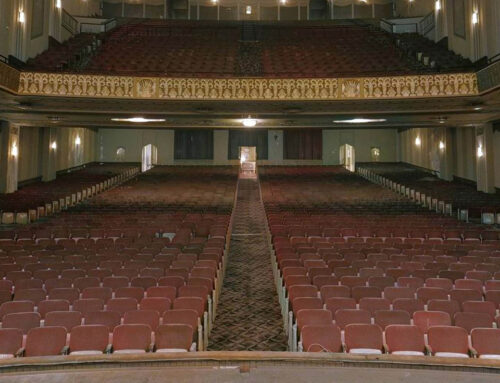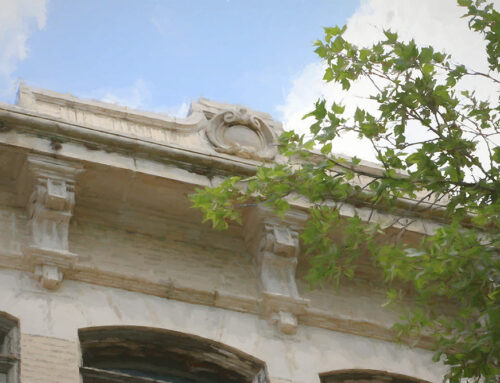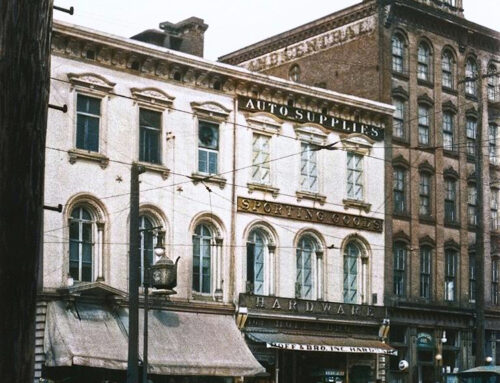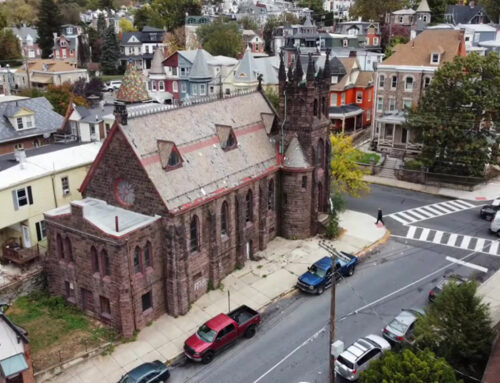Across the ridge of Mount Penn, Reading, PA, extends the Skyline Boulevard or Skyline Drive. Motorists who fail to drive across the boulevard when visiting the City of Reading are depriving themselves of an un-paralleled view of Reading and countryside for miles around. On the hottest days, cool breezes sweep over the mountain top.
Construction of Skyline Boulevard, as it was initially called, began on February 1, 1932 and was completed and opened on June 24, 1935. The roadway and “Skyline Drive wall” was initially funded by the City and County and later by the Federal government under the Administration of President Franklin D. Roosevelt and his creation of the W.P.A.
Built by the unemployed of Reading as the City’s contribution to the support of the unemployed, the boulevard represented the largest public works relief project undertaken in Berks County. The project provided employment for thousands of unemployed workers. Workers were paid 40 cents an hour or $16 a week.
The first section of the Reading’s Skyline Boulevard, from the Pagoda to the tower, was formally dedicated on July 1, 1932. At 7:29 PM, a car driven by Mayor Ermentrout broke a white silk ribbon stretched across the new boulevard just north of the Pagoda and led a parade of cars along the boulevard to the tower where a dedication ceremony was held. Lebert H. Weir, national authority on parks of the National Recreation Association, was the chief speaker at the dedication ceremony. L.H. Weir said “the work done here is of a rank among the highest in the country.”
The mayor paid tribute to the men who worked on the mountain, and he congratulated the poor directors upon their policy of work rather than charity. Mayor Heber Ermentrout had high hopes for the highway in the sky. “I cannot help but feel that with this improvement the coming generations will be privileged to enjoy the beauties of the mountain their parents enjoyed in the years gone by,” he said.
In addition to the roadway, workers built a stone wall running most of the distance along the city side of the road from the Pagoda to the tower. Stone from the old tower (destroyed by fire on April 23, 1923) was used in the walls and the new road.
The original tower atop Mount Penn was the main point of interest for riders of the old Gravity Railroad which operated from 1890 to 1923. When the tower was destroyed by fire, the mountain railroad ceased operating.
Below: Original Mt. Penn Tower and Tower Hotel.

The present tower was built and dedicated in 1939. It was built at a cost of $25,000 as a Public Works Administration project. The present fire tower is named in honor of William Penn, founder of Pennsylvania. Tony Pietrovito, a Lieutenant in the Reading Boys’ Nautical club, conceived the name while attending the pageant “Penn’s Dreams,” presented by the 1930 graduation class at Reading Senior High School. He sent his suggestion to the Mayor Stump who presented it to council where it was adopted.
Below: William Penn Memorial Fire Tower, Mt. Penn.

A high stone wall was also built below the old Tower Hotel. The Tower Hotel, formerly the Summit Hotel, was built by William S. and Henry Schwartz in 1891, a short time after construction of the old tower. The hotel was a 24-room structure. The city took over the property in 1931 as Mayor J. Henry Stump announced that the grounds would be turned into a recreation center similar to the area at the Pagoda and that concessions would be rented. During ensuing years, various tenants tried vainly to make a success of the enterprise as a dance hall, roadhouse and even a bingo parlor. It was last leased in 1952. The hotel structure was razed by fire in October 1959.
Below: Old Tower Hotel, Mt. Penn.

With a brief and simple ceremony, the second stretch of Skyline Boulevard from the Summit Hotel to the “North Bend” was opened to public on July 5th, 1933. The North Bend was where the old time Gravity Railroad made its turn to begin the descent off the mountain. The ceremony consisted of an abbreviated automobile caravan and a few chosen words by Mayor Ermentrout explaining how the road had been built, and that another spur, to Angora road, would probably be completed within 30 days.
Below: Location of “North Bend”

The third stretch of the Boulevard from the North Bend triangle, eastward and southward along the course of the old Gravity Railroad to Angora Road was completed in September of 1933. No special ceremony was held for the opening of the third section. The stretch of road was dedicated to the memory of Friedrich List.
Friedrich List was Pioneer railroad builder and editor of the Reading Adler between 1826 and 1831. Friedrich List was born in 1789 and died in 1846, shortly after his return to Germany. List created the first anthracite-carrying railroad in America, from Tamaqua to Port Clinton line. It was later acquired by the Reading Railway.
Below: Friedrich List

The fourth stretch from the North Bend to McKnight’s Gap was the rockiest and roughest portion of the entire Skyline Boulevard. Great rocks had to be blasted away along a course of the roadway.
The fourth and final stretch of Skyline Boulevard from the North Bend to McKnight’s Gap was opened and dedicated on Saturday, Sept. 22, 1934. The opening of this stretch of roadway completed the magnificent three mile stretch of the scenic Skyline Boulevard atop Mount Penn. Several spur roads were still under construction, but were given other names when completed.
As Mayor Heber Ermentrout severed a white silken ribbon stretching across the final stretch of the boulevard he envisioned it as an attraction; that will equal, if not better, the Pagoda in drawing visitors from all over the United States. The honor of being the first to drive over the new portion of the Boulevard went to 140 musicians of the Philadelphia Rapid Transit Company, in Reading on a reciprocal visit to the Ringgold Band. They rode in automobiles provided by members of the local musical organization. Rain did not prevent the ceremony.
A parade of about 40 automobiles and busses from Fourth and Walnut streets to the top of the mountain preceded the ceremony. Led by a motorcycle escort, the parade attracted much attention as it proceeded through City Park to the Boulevard by way of Egelman’s Park.
The final link at the northern end of the scenic drive, extending from Bern Street and Oak Lane in Hampden Heights to the McKnight’s Gap bend in the boulevard was opened on June 24, 1935.
Below: Oak Lane Entrance to Skyline Drive.

In August of 1935, a bronze tablet and boulder memorializing the work unemployed men did on the Skyline Boulevard was unveiled by city officials. J. Bennet Nolan, Reading lawyer, was the chief speaker at brief exercises held on the boulevard near the Pagoda. The inscription on the tablet is as follows:
Skyline Boulevard
Dedicated by
The City of Reading
To those Citizens, who, in a period
of economic depression, labored to
build this Boulevard.
1932-1935
Mayor
Heber Ermentrout
Councilmen
William J. Smith
George M. Yocom
Jesse George
William C. Hoverter
Frederick A. Muhlenberg
Emil A. Nuebling
John H. Rorke
Superintendent of Construction
Harry F. Sullivan
Below: Bronze Dedication Tablet.

Started on February 1, 1932, the five sections, four and one-half miles long and about 27 feet wide, of permanent stone and rolled blacktop construction, cost between $500,000 and $600,000. The city gave $100,000 at the start, the county $50,000. With other costs, the first section, from the Pagoda to the hotel, involved about $175,000.
Access to the boulevard is possible by means of various mountain roads. The old Mt. Penn Boulevard extending from City Park to the Pagoda, winding around the southern tip of the mountain, is the most popular route. From City Park to Hampden Heights, over the old and new roadways, the route is about seven miles long. Mt. Penn Boulevard was built by the Board of Park Commissioners of Reading between the years 1893 and 1899. At completion, its length was calculated to be 3 1/2 miles – at grades between 3 and 10 per cent.
Construction of a boulevard was a project long contemplated. During the early summer of 1870 a party of citizens of Reading, vacationing near Cape May one afternoon, gathered on the veranda of their cottage following a pleasing carriage ride, and began discussing how nice it was to take easy paced drives along the seashore and what a shame it was no such opportunity were available back home.
In 1898, William A. and John A. Witman, and those leasing their quarry operations where the Reading Pagoda now stands, brought suit against the city for damages resulting from construction of the Mount Penn Boulevard which cut off access to the quarries, making it virtually impossible to bring stone down the hillside. Below is a photo of the stone crusher that once stood on slope of Mount Penn where the Pagoda now stands. What is seen in the photo was clearly visible from the city below. On May 17, 1900, after a trial of two days before Judge Endlich, a jury in the damage suit of William A. and John A. Witman against the city returned a verdict for $2,000 in favor of the plaintiffs. William Abbott Whitman completed the construction of the Pagoda on the site of the old quarry in 1908.
Below: Quarry Stone Crusher.

Below: Reading Pagoda, 1908 Construction Photo.

In addition to the construction of Skyline Boulevard by unemployed, workers of a Civilian Conservation Corps. (CCC), established in the Fall of 1933, helped in various projects in the Mount Penn Parkway System.
The Civilian Conservation Corps. (CCC) was a public work relief program that operated from 1933 to 1942 in the United States for unemployed, unmarried men from relief families as part of the New Deal. Originally for young men ages 18-25, it was eventually expanded to young men ages 17-28.
The local CCC camp was located on Pricetown road, north of the city line. Nearly 200 boys occupied the camp while work on the Mount Penn Parkway System was in progress.
Below: Civilian Conservation Corps. Camp, Pricetown Road.

The CCC campers contributed works and supplies valued at $60,000 for trails and other improvements on the mountain for picnic, and recreation for hundreds of people, including permanent stone ovens and rough timber benches and tables, attractive shelters, and installed water service lines for toilet facilities. The CCC also constructed access roads leading to the picnic areas with adequate parking space provided at frequent intervals to accommodate picnickers.
The CCC graded and developed Drenkel field which today is used for flying drones and model airplanes. The field was the site of an old orchard.
One of the beautiful spots developed by the CCC was an old Campfire Girls Circle, a short distance from the Pagoda, shown in the photo below.
Below: Old Campfire Girls Circle near Pagoda.

The reconstruction of Skyline Drive began in May of 2017. The more than $1 million project, a partnership among the city and Alsace and Lower Alsace townships, was funded in large part by a $969,000 grant from the state Department of Community and Economic Development. The project consisted of milling, reconstruction, base repair, paving overlays, and stone wall repair, and a bike and walking lane for Skyline Drive.
A beautiful automobile driveway is an asset to any community. But if this is to be the chief use of the skyline drive, then it will fall short of being the great public improvement it can be.
Its chief use should be not as a motor speedway but as a means of transporting to a great mountain park the vast majority of people who are not merely interested in a drive but who are thirsty for the fresh air of the woods, hungry for the coolness of mountain trails, eager for the song of birds and all the multitude of simple pleasures that woods and open spaces and sun and air hold.
Most of things that we have been taught are worthwhile in a material world cost a lot of money. The worthwhile things on Mount Penn cost very little money. The big job, the expensive job, is the road maintenance. The rest – the establishment of picnic grounds, equipping them with rustic furniture and ovens, the building of trails, the marking and labeling of the plant life along the trails, the creation of bird sanctuaries, the construction of small athletic fields, the designing of groves where meetings and reunions and gatherings may be held – is cheap and comparatively easy.
Why should children be condemned to play in the streets or playgrounds when the Drenkel field area on Mount Penn is vacant and idle? What great or expensive problem is there in taking these children day after day to a playground on the skyline?
Why should a luncheon club plan all summer to hold one single meeting in the country when in 10 minutes its members could drive each meeting day each week for a meeting under the sky on Mount Penn?
The Skyline Boulevard will always be a motor driveway for many. But it can be made a service road for the majority – a road which leads somewhere, which leads us into a great park, there to spend our time not in burning gasoline but in the varied pleasures of the open.
It took courage on the part of the poor directors of the City in the 1930s to buck the reactionary objections to the spending of money for work rather than charity. Some of these objectors were men in high places. It took courage for the City administration to insist against these same objectors that the work plan be given a full test and that all city funds be so spent.
And now, will it again call for courage to oppose the reactionaries who would spend money on charity rather than work.






Leave A Comment